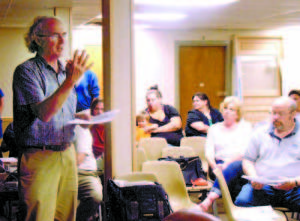Consultants weigh in on cell tower plans

INDEPENDENT OPINION — Terrence DeWan of Yarmouth, who specializes in visual impact analysis, was one of two peer review consultants that testified at Tuesday’s public hearing by the Bridgton Planning Board on AT&T’s cell phone tower application on Hio Ridge Road. The other consultant was Steve Bradstreet of Ransom Consulting, who focused on site development impacts.
(Geraghty Photo)
By Gail Geraghty
Staff Writer
Two of three independent consultants hired to review AT&T’s plans for a controversial cell phone tower on Hio Ridge Road reported their findings at the Bridgton Planning Board’s Tuesday meeting. Each found that the plans lacked some documentation they would have preferred to see, but those deficiencies alone were not deemed serious enough to suggest that the board should reject the plan.
However, the most crucial question of whether an alternative site could serve AT&T’s coverage needs has yet to be addressed. That is the job of the third consultant, Ivan Pagacik of IDK Communications, and he was unable to attend.
The board voted to continue the public hearing until Tuesday, Sept. 2, when it is expected that Pagacik will report his findings. Afterward, after six months spent reviewing the cell tower application, the board will be in a position to make a final decision.
As they have done so since the beginning, Hio Ridge neighbors who strongly oppose the tower turned out in force. But on Tuesday, the floor belonged to the consultants.
First up was Steven Bradstreet, senior manager at Ransom Consulting of Byfield, Mass. He outlined nine areas where information or analysis was lacking when he began his review of site development impacts. He said Barry Hobbins, agent for AT&T and its partnering construction firm of American Towers, had addressed several of the more minor deficiencies in documentation, such as backup data supporting the noise analysis and site removal costs. But other information was still missing, he said, especially evidence that no vernal pools exist on the land AT&T plans to lease for the tower at 214 Hio Ridge Road.
Bradstreet said that a true assessment of vernal pools can only be done in April or May, when amphibians lay their eggs. For that reason, he discounted AT&T’s vernal pool study done by New England Land and Water in November of 2013.
“They didn’t observe (any eggs) in their study. I’m sure they didn’t,†because of the study’s timing, Bradstreet said.
But Hobbins said it would be unreasonable to require AT&T to wait eight months to settle the question, especially when the property’s forested wetlands are exempted from Shoreland Zoning Review. Hobbins said the tower plans must also pass muster under state and federal guidelines, and conform to the rules of the Telecommunication Act of 1996.
“If you really want to challenge this on the basis of vernal pools, God bless you,†said Hobbins. He said AT&T would likely agree to a conditional approval that required a vernal pool study next spring.
The board agreed that a conditional approval hinging on a vernal pool study would set a bad precedent for the town.
At the very least, however, Bradstreet said the plans should stake out the perimeter of the tower construction site and provide more details on plans for erosion control, site grading and details of construction. “I want to see where it drains,†he said, to assess the impact to any wetlands and abutting property owners.
Next up was Terry DeWan, of Terrence J. DeWan & Associates of Yarmouth. In assessing AT&T’s visual impact analysis, he said his main concerns had to do with the accuracy of the two balloon tests that were done, and the lack of information about scenic resources that might be affected.
But in the final analysis, DeWan said his preliminary conclusion was that the cell tower “will not have an unreasonable adverse impact on the immediate abutters, the local neighborhood, the community as a whole, or locations that have been identified by the town’s Comprehensive Plan.†He said the operative word is “unreasonable,†because it’s clear that abutting neighbors strongly believe the tower would have an adverse impact.
In summary, DeWan said, “There are a number of unanswered questions that the applicant should address†before the board can make an informed decision.
“The ball’s back in your court,†he told the board.
Hobbins said AT&T has repeatedly made concessions in response to the concerns of neighbors, and DeWan agreed that with regard to visual impact, “The applicant took a lot of this to heart, and has submitted new information.
Hobbins added that AT&T agreed to move the tower back by around 50 feet from the nearest abutter, George Goula. Moving it further back, as neighbor Paul Veit suggested, wouldn’t make any substantial difference.
“The fact is, no matter what we do, the neighbors are not going to be happy and are not going to want this tower,†said Hobbins.
Prior to ruling on the upcoming issue of alternative sites, Veit suggested to the board that they consult an attorney to determine whether, as he alleges, there was space available on the nearby Sam Ingalls tower to co-locate their antenna there at the time that they submitted their application.
“Legally, (the owner of the Sam Ingalls tower) had that spot open for three quarters of a year, and (AT&T) refused to consider it,†Veit said.

